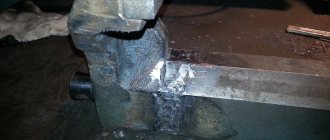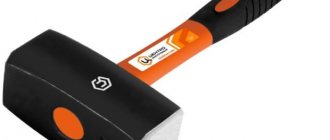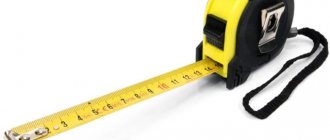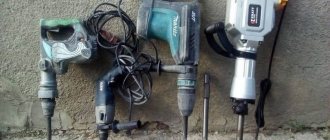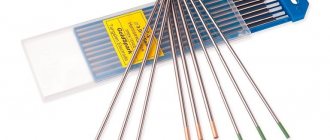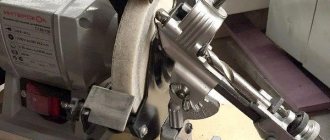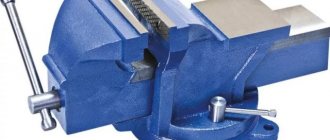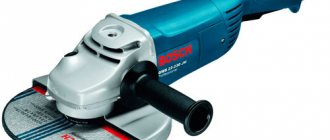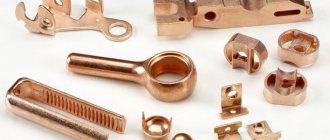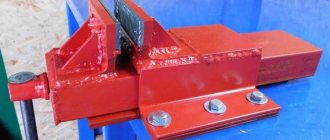Vise device
A simplified design of the vice consists of two jaws and a locking mechanism with a handle, designed to tightly clamp parts during processing.
One jaw is stationary because it is attached to the static body or frame of the vise, while the other supports movement by sliding.
The locking mechanism consists of the following elements:
- Lead screw – connected to the jaws, passes through the vise structure. Most often it has a trapezoidal thread and is made of steel. The movement of the screw is controlled by a handle located at the outer end.
- The base plate or frame is most often made of cast iron. There are durable steel and lightweight duralumin variations.
- The jaws are often replaceable with a screw fastening. The movable lip is usually cast iron. Soft variations involve making this part from plastic or non-ferrous metals.
The tool is fastened to the surface using screws or a clamp. Models with magnetic fixation are less common. Designs with a flat base or increased weight are also available without fasteners.
When the screw is rotated clockwise, the movable jaw moves towards the frame, thereby fixing the part. When rotated counterclockwise, the handle moves the sliding jaw away from the stationary clamp and opens the gap between them.
Rigid fixation helps when sawing, drilling or otherwise machining clamped parts.
Carpentry tools
They differ in that they are designed to work with parts made of plastic or wood. They are attached to the table or frame using screws. Since you have to work with soft materials, a wooden gasket is fixed to the jaws. This allows you to avoid damaging the workpiece. Some vices can be combined, made of cast iron and wood.
Advantages of carpentry types:
- Allows for careful fixation of wooden, plastic, or soft metal parts.
- Due to the fact that the jaws are fixed at the same level with the workbench, it is possible to process large products in the same plane.
- The sponge solution has a long stroke.
- Fastening systems are presented in a wide range. There are products that do not have frames and are used to compress parts of an unfinished structure. A kind of hand vise clamp.
Minuses:
- Not suitable for fixing rigid parts.
- Serve as a household handy tool.
- Options without workbenches have reduced grip rigidity.
- Products with workbenches have an expanded configuration, which requires additional space and lighting.
Types of vices
The main types of vices are metalworking, machine, carpentry and manual.
Bench vice
An all-metal tool that is mounted on a workbench or table and secured to the base with bolts.
- The design differs between chair and parallel vices.
- Available in stationary and swivel versions, allowing you to work from different angles.
- The width of the jaws is 45-200 mm.
- The stroke length of the movable lip reaches an average of 140 mm.
Parallel vice
- They are divided into rotating and non-rotating. The first ones rotate parallel to the base around an axis by 60 degrees or more. Fixed models are rigidly fixed and designed for work in one position.
- The movable jaw moves when the screw rotates parallel to the fixed part.
- The base of the tool is cast from cast iron, and the moving parts are made from carbon steel.
- The overhead jaws of high-strength models are made from U8 tool steel, complemented by a cross-shaped notch, and are attached to the main jaws with screws after hardening.
Chair vice
Outdated design type. Previously they were attached to a chair-shaped base. Modern devices are fixed on workbenches.
- The structure is made of forged steel. Consists of a body complemented by sponges.
- The working surface of the jaws is reinforced with screw-on hardened plates or a layer of U8A steel is welded onto it.
- The working surface inside is covered with notches for strong fixation of workpieces in a vice.
- The fixed jaw is equipped with a claw for fixation, the rod is clamped with a bracket.
- The width of the jaws is 100-180 mm. In terms of opening length, options are available for 90-180 mm.
- The jaws are moved by rotating a screw with a rectangular thread, and moved apart by inserting the screw into the tubular nut.
Models are most often equipped with an anvil platform. The frame is a structure consisting of a base and a rotating disk, which are connected in the center with screws or additionally secured with a return ring.
When the screws are loosened, the ring releases the movement lock.
According to GOST 4045-75, the types of bench vices differ from those presented. Three types are declared:
- general purpose;
- with rotating jaw;
- with additional pipe jaws.
The standard applies to models with jaw widths of 63-200 mm. Rotary and non-rotary manufacturing options with or without accelerated idling are assumed.
Machine vice
A tool of increased precision, which differs from locksmith models in the absence of play or its small run-up. Designed for production work.
- Fixed on industrial workbenches for machining large parts.
- For ease of adjustment of parts, they are often equipped with a rotating mechanism.
They are divided into basic and sine; in addition, a different number of axes is provided:
- Basic or stationary - the part is attached perpendicular to the tool.
- Sine – the workpiece is fixed at an arbitrary angle.
- Multi-axis – supports rotation along several coordinate axes.
Machine vices for home use are also available, but they are smaller in size than production models.
Hand vice
Compact tool for processing small parts, does not need to be attached to tables. There are two types, differing in the fixation system.
- With jaws – consists of a jumper with a screw, steel lips and a handle. The convergence of the jaws is achieved by rotating the handle. The cone is located on the reverse side, enters between the shanks of the jaws, causing them to compress.
- With levers - reminiscent of pliers with a latch. They have a locking mechanism, which consists of two levers that clamp the jaws.
Holdfast
Used when working with wooden and plastic workpieces. Most often they are fixed with screws to the table or frame. Variations available with front clamp.
- Wooden spacers are usually attached to the jaws to hold the workpiece without damaging the surface of the workpiece.
- Overlays are provided to prevent marks on parts made of light or soft wood.
- Front mount models are suitable for vertical surfaces.
- There are models with a combined clamping device - a combination of cast iron and wood.
Some carpentry vice models are equipped with quick-release screws for easy positioning of the movable jaw and pre-clamping.
Manual milling fixture
The rotary vice, thanks to the rotating disk, has a rotation radius of 360 degrees. Together with them, the part clamped in them also turns. The disk is fixed using a threaded rod, as well as a static regulator located behind the rotating part. To improve fixation, a recess is provided in the rotating mechanism.
A hand vice is fixed on top of the disk. They are equipped with 2 plates with damping material. The rails are located perpendicularly. These are guides along which one of the plates moves.
A threaded rod is used as a regulating element. It is welded to the central part of the plate from the inside. On the other side of the rod there is a handle. This end is threaded through a tightly secured regulator with a thread on the inside.
The distance between the vise plates is about 1 mm, with the rod fully twisted. This is necessary in order not to damage the vice.
Vise designs can come in different modifications. For example, with 2 movable plates. The device has a complex mechanism. In other cases, a lever is used instead of a handle, as well as a transfer unit.
As a rule, such a vice device is used in small workshops. Locksmith tools can be quickly repaired. It is easy to disassemble or install on the machine table. It is convenient and practical to use.
How to choose a vice
When choosing a vice, the scope of their application and the size of the workpieces that are planned to be installed in them are taken into account.
Mechanical - require increased clamping force when processing parts, so rigid models made of steel are preferred rather than powder metal.
- A lead screw with a triangular metric thread wears out quickly, and the clamping force is not enough to process large workpieces.
- The weight of a structure indirectly characterizes its strength.
- To process parts in a vertical position, modernized bench vices are selected. Their base rotates 360°. More often equipped with an enlarged anvil.
- For round workpieces, models whose body is equipped with prisms are preferred. These vices are often used with a slider.
Carpentry - pay attention to the diameter of the auger and the uniform alignment of the rods. Parallel movement is assumed when screwing.
- If the tool moves unevenly, the risk of damage to workpieces increases.
- Additionally, the clamp linings are inspected; when choosing, they are checked on a piece of plastic. It is important that there are no marks or dents left on the surface.
- In models with a workbench or frame, the flatness of the plane is visually checked. To do this, you need to stand in such a way that the nearest corner of the bed is at eye level - flaws become noticeable when the plane looks like a string.
- The front vise is only available with a screw mechanism and a guide rod. It is worth considering whether this is convenient for current operational needs.
Machine tools are chosen for processing materials of increased rigidity, so functionality is a priority.
- Jaws for fixing workpieces of lower height than other types.
- Compared to a bench vice, the design is more rigid.
- The tool secures the part at a specific angle and supports rotation around a vertical axis.
When choosing, the material from which the tool is made is taken into account. Models made of hardened steel are preferred.
If this option is not within your budget, try to choose a device with steel moving parts, as they are subject to the greatest wear.
Anti-corrosion treatment of the tool is important - the coating is most often applied to threaded parts, but it can also be solid.
Double machine tools - support the simultaneous processing of several parts, but are inconvenient for constant household use.
Sine - used for complex processing of parts. They support the slope of the part fastening in several mutually perpendicular planes.
Manual - when choosing, it is worth checking the parallelism of the jaws, the quality of the convergence and the size of the gap.
- Handle play is a sign of a tool that will have difficulties.
- The width of the working gap in the open state is a parameter that determines whether the workpiece will enter the tool. The gap in manual models is usually small, so you should carefully try on the dimensions.
- Check to see if the teeth leave indentations in soft metal. In this case, a tool with a lower clamp thread height is preferable.
The rotating base for fixing the tool is convenient to use, but reduces the rigidity of the structure. The rotation mechanism is the weakest link of the tool, so this functionality is chosen only in cases where work is impossible without it.
When choosing, it is worth determining the angle that is most often required during work. Variations with a minimum rotation angle and models rotating 180 or 360 degrees are available.
Static models are more reliable, but choosing an attachment point is made difficult by the parameters of the workbench. With non-standard workpieces, additional fixing devices are more often used: fastening with bolts or gripping with a clamp.
Design, purpose and types of mechanism
Before we begin to consider the design of bench vices, it is worth understanding their purpose. They are necessary in order to clamp this or that object, to fix any part of the mechanism.
Vices can consist of various parts, but they are based on a screw pair. The screw is located in the moving part, and the nut is located in the stationary part, which determines the operation of the device.
When choosing the type of vice, it is best to base it on the purpose for which it is needed. It is important to remember that the choice of a suitable device depends on the following parameters:
- the material from which the device is made;
- sizes;
- clamping force;
- country of origin.
Previously, the most common vices were considered to be cast iron, because they were actively developed in Soviet times. Now this material should be given preference only if the master does not intend to bend steel blanks or structures. Cast iron is quite fragile and is not at all suitable for completing these actions; in this case, it is better to give preference to a steel vice. When choosing the type of tool, you should listen to the following tips:
- If you are going to produce various cylindrical products, you should pay attention to non-standard types of vices.
- When a tool is needed exclusively for home use and you do not need to clamp large parts with it, it is better to choose a small, compact device.
- If a craftsman does not have a workbench, but does not need to perform operations that require the use of brute physical force, a bench vise is ideal for him. They are secured using various clamps.
- When using large parts, you can confidently choose a vice with pre-expanded jaws. When choosing this type of machine, processing will not require much effort, so the machine will be easy to use.
- It wouldn't hurt to have a mini vise in your household. They will help with minor repairs around the house. They can also be used as hand tools and are indispensable when you need to deal with a stuck nut.
Which vice is better?
Determining the best vice by type cannot be correct, since their functionality is different. In this case, an assessment of the working elements of the structure is used.
- Sponge sizes . Wide jaws prevent workpieces from slipping during operation. The effective surface area is increased by using pads, but a vise that comes with wide jaws is preferable.
- Stroke of the movable jaw . The vice rarely opens to its full width when working, but the deep stroke provides clamping versatility. If the tool is not selected for one-time work, models with a maximum stroke length are preferable.
When choosing, remember that the stroke is determined not only by the height of the workpiece - you also need a margin for inserting the part.
- Handle . It should be convenient, since it is with this part that the main interaction will occur. Large-diameter metal handles are more comfortable than rod-type analogues.
Adjusting the pressure when clamping the part should not be too tight. This parameter depends on the length of the working part of the handle - the distance from the center of the screw to the tip.
How to use a vice
Correct operation of a vice consists of timely care of the tool and compliance with a number of precautions.
Care
To keep your vice in good working order, keep threaded and moving parts clean by wiping them with a cloth and solvent after each use.
Lubrication - parts and assemblies are treated with engine oil to maintain smooth opening of the movable jaws. The procedure also helps protect against corrosion:
- spread the jaws completely and apply a layer of lubricant;
- close and open the parts several times to evenly distribute the coating.
Rust – mechanical cleaning is ineffective; special anti-corrosion compounds are often additionally used.
- Apply the substance to the rust and leave overnight;
- Clean the surface of the tool with a metal brush until the rust comes off;
- Rinse off the substance with water and dry the vice completely.
Precautionary measures
Vices are designed for certain loads. Failure to comply with the instructions may result in premature failure of the instrument.
- Mechanical models are sensitive to changes in the volume of parts - it weakens the fixation of the lips. This type of equipment is not suitable for processing heated steel parts.
- Lengthening the handle of the vice is unacceptable, especially in clamping models, as it increases the load on the structure.
- Models with a bed are fixed only on flat surfaces for safety reasons and to prevent workpieces from breaking.
In parallel models, it is important to avoid bending the clamped parts to avoid damage to the mechanism.
Vise clamping force and what it affects
Clamping force is a value that reflects the effectiveness of a tool. The larger the vise size, the greater the clamping force. This value is measured in Newtons, and the higher the compression force, the more force will be required to apply to the workpiece to move it from place.
The clamping force on the tool for immovable fixation of workpieces is the most important technical parameter. Not just the quality of work, but also efficiency and safety depend on this indicator. If the clamping force is insufficient, the workpiece will move and vibrate during processing, which will certainly affect the quality of processing. In addition, if in the process of working with a workpiece it changes its position or even falls out of the clamp of the vise jaws, it can cause injury to the master.
To exclude such cases, the master needs to know the following:
- The clamping force of the vice must correspond to the size of the workpiece
- The larger the dimensions and weight of the tool, the higher the clamping force of the jaws
- Work with workpieces clamped in a vice should be performed exclusively in protective clothing, observing safety precautions
The optimal clamping force for medium-sized locksmith models ranges from 15 to 30 kN.
This is interesting!
The clamping force of the vice is directly proportional to the size of the jaws.
Guarantee
Warranty obligations apply to equipment with the correct set of documents:
- A coupon with the serial number, the date of purchase, and the seller’s stamp. In some cases, the buyer's signature is required.
- Documents confirming the purchase: invoice, cash receipt or sales receipt.
Manufacturers' obligations do not apply to the following elements:
- replaceable accessories – depending on the model, these are often lips or fists;
- devices for surface mechanical protection – casings, couplings;
- parts with rapid wear or limited service life - guides or rollers made of plastic and rubber, bearings.
Warranty service will be denied if the tool shows signs of mechanical damage, has been used for other purposes, or has been worn out as a result of improper care.
Malfunctions and repairs of vices
More often, the functional parts of the tool or the body wear out.
Hull destruction
Occurs due to excessive loads or weakness of the metal. Pieces break off in models made using cast iron elements. Repair involves welding the damaged element and the base. Performed in the service or at home.
Nickel or iron-nickel electrodes are most often used. Welding of vice nut bodies is performed using the gas-powder method.
Screw wear
The rod and nut with trapezoidal thread are removed and then replaced with an analogue.
In the absence of an analogue, it is turned independently using a turning tool:
- Alternatively, a suitable part is turned using a drill press or hacksaw, grinder with a cutting wheel.
- The threaded part is cut off from the rod.
- In the remainder of the rod, holes are drilled along the axis of symmetry.
- The parts are aligned using a pin and then welded.
Worn locking pin
A sign of a malfunction is that the shaft unscrews, although the part remains clamped and cannot be removed. Repair is labor-intensive and requires complete disassembly of the tool and grinding of a new pin. The main problem with replacement is the assembly. The performance of the vice depends on its correctness:
- On the cleaned base, the main lips are moved as deep as possible to the side of the body (usually it is located on the left).
- The strips are installed and fastened one by one, then to firmly fix them you will need to slightly move the lips in the opposite direction.
- A screw clamp and the lead screw itself are inserted inside, after which the structure is secured with a nut.
- A new pin is mounted, pre-lubricated with lithol.
- The protective cover is installed and secured with screws.
- The tool is screwed to the base.
The listed faults cannot be repaired without available equipment or similar parts. If they are not, the tool will require service repair.
Vice manufacturers
Some manufacturers do not provide warranties for hand-held household tools; the obligations apply to professional models.
Dexx
Ukrainian manufacturer of hand tools and accessories. Bench vice with rotation function. 1 year warranty.
FIT
Manufacturer from Canada. Budget models of pneumatic, electric and hand tools. Bench and machine vices There is no warranty for hand tools.
IRWIN
American manufacturer focused on hand tools. Bench vice with an anvil made of fine-grained cast iron. The manufacturer's warranty is lifetime, but dealers in Russia claim a period of 1 month.
KRAFTOOL
Manufacturer from Germany. Mostly hand tools are presented, including vices with clamps. Warranty period from 12 months.
Sturm
Russian manufacturer, several brands of budget tools. Bench vices and benches are available. The warranty period is 14–25 months depending on the tool.
Wolfcraft
German manufacturer specializing in tools for household work. Aluminum machine and universal vices. 5 year warranty.
